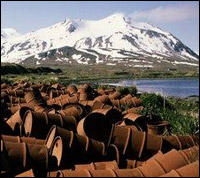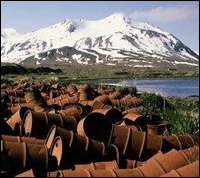
The future of the Arctic Refuge?
“The threat to the Arctic National Wildlife Refuge has never been greater than it is today,” according to Brian Moore, legislative director for the Alaska Wilderness League.
And, though the battle over the refuge has a Groundhog Day quality to it — haven’t we heard this same alarm sounding before? — this time advocates on both sides of the issue agree: Congress is closer than ever before to green-lighting oil and gas drilling in one of the largest remaining undeveloped wild areas in the United States.
Wednesday, the Senate Energy and Natural Resources Committee voted 13-9 to include in a hulking budget package a provision that would not only allow drilling on the coastal plain at the northern edge of the Arctic Refuge, but also require that the land be leased to energy developers as a means of generating revenue for the federal treasury.
If this congressional maneuver sounds familiar, that’s because it’s part of the second phase of a budget-bill deliberation process that began early this year. The initial “resolution” phase outlines possible budget cuts and increases within congressional committees — suggestions that aren’t legally enforceable; the second, called the “reconciliation” phase, hones these instructions and locks them in, carrying the force of law.
In March, a resolution package that contained similar language paving the way for drilling in the Arctic Refuge passed the Senate by a narrow margin, instructing committees to trim their budgets by specific amounts. The Energy Committee’s goal for cuts or offsets was set at $2.4 billion over five years. That’s almost exactly the amount that the Congressional Budget Office predicts the feds would receive over the next five years from sales of energy leases on the refuge’s coastal plain.
Drilling advocates are piggybacking the Arctic Refuge provision onto the budget initiative because reconciliation bills are immune to filibuster, thus requiring only a simple majority vote to clear the Senate. That vote is scheduled to occur within the next few weeks, and though Democrats are expected to unanimously oppose the bill, the 55-44 GOP majority in the Senate gives drilling advocates a comfortable margin for victory, even if there are a few moderate-Republican defectors.
Critics argue that the refuge drilling provision is entirely out of place in a budget bill. “The whole point of the resolution process is to hammer out the budget — it’s not to reverse existing legislation or enact new legislation of any kind,” says Eleanor Huffines, Alaska regional director for The Wilderness Society. This is the logic that Senate opponents of the bill, such as Maria Cantwell (D-Wash.) and Jeff Bingaman (D-N.M.), will invoke if they proceed with plans to challenge the provision under the Byrd Rule, which requires a budget bill to have 60 affirmative votes if it includes extraneous provisions.
Advocates of the drilling language counter that the Byrd Rule is effectively moot in this case, given that a precedent already exists for this very maneuver: The GOP-controlled Congress of 1995 managed to successfully pass a refuge-drilling provision in a budget reconciliation bill, which was then promptly vetoed by President Clinton. This time, of course, there’s no chance of a veto from the Oval Office.
Arctic Refuge defenders are quick to assert that there’s still hope, but it likely hinges on strong opposition to other parts of the bill, not the drilling provision itself. The budget resolution was unanimously opposed by Democrats in both the House and Senate in March for fear it would spur draconian cuts to a broad swath of social programs, including Medicare, food stamps, and college loans. All Dems in Congress are expected to vote against the budget initiative on this go-round too, and they’re getting support not just from environmental groups but from a wide range of organizations including the People for the American Way, the National Women’s Law Center, the Leadership Conference on Civil Rights, and the AFL-CIO, all united under the umbrella group Emergency Campaign for America’s Priorities.
“Many of the entitlement cuts hit the most needy segments of the population,” says Melinda Pierce, legislative director for the Sierra Club. “But post-Katrina, efforts to short-shrift the disadvantaged are under much more scrutiny, so there’s a groundswell of resistance to many components of this bill beyond drilling in the refuge.”
Where There’s a Drill, There’s a Way
The refuge-drilling provision, in an attempt to fast-track the sale of drilling leases, would weaken the process of reviewing proposed extraction projects for their potential environmental impacts. It would also curtail the authority of the U.S. Fish and Wildlife Service to place constraints on methods of road-building and extraction in the interest of protecting land and wildlife. The environmental exemptions “are completely at odds with a precautionary approach to oil development in a sensitive area,” says Huffines.
And while advocates of the drilling language claim that only 2,000 surface acres within the refuge would be disturbed by the building of infrastructure such as airstrips and gravel berms necessary to extraction, critics counter that this number doesn’t account for the impact of building roads and other support facilities. They claim that the affected area would be far larger.
The provision requires that at least two major lease sales happen by 2010, but environmentalists argue that in order to come anywhere near generating the expected revenue, the entire 1.5 million acres of the refuge’s coastal plain would have to be leased. Even then, drilling opponents don’t see how the leases could bring in the amount the Congressional Budget Office predicts — an estimated $5 billion, half of which would go to the feds and half to the state of Alaska. The average going rate for a drilling lease on a productive oil field in the U.S. is about $55 per acre. The feds would have to lease all 1.5 million acres of the coastal plain at $3,333 per acre — more than 60 times the going rate — to generate the expected revenue. The CBO’s figures are “grossly exaggerated, if not fraudulent,” says Huffines.
Surprisingly, while chances of victory for drilling advocates in the Senate are quite high, they’re weaker in the House, say observers. The House has voted to allow drilling in the Arctic Refuge a handful of times in the last four years, but that was usually with support from moderate Democrats. The current highly controversial budget reconciliation package is expected to get a “no” vote from all House Democrats, and there are 24 House Republicans who’ve publicly voiced their opposition to the Arctic Refuge provision being included in the budget bill via a letter [PDF] to Rep. Richard Pombo (R-Calif.), chair of the House Resources Committee. “If those 24 GOP representatives stand by their convictions, the House could very well stop the ANWR provision in its tracks,” said Moore of the Alaska Wilderness League.
But even if the Arctic Refuge provision is stripped out of the House version, the bill still has to go to conference committee, where compromises between the two chambers of Congress are struck. If drilling advocates are victorious in the Senate, they could negotiate during these deliberations to slip the provision back in.
Environmentalists, most Democrats, and the handful of moderate Republicans who’ve been fighting for decades to protect the Arctic National Wildlife Refuge are now waiting on pins and needles to see how the budget brouhaha will shake out.


